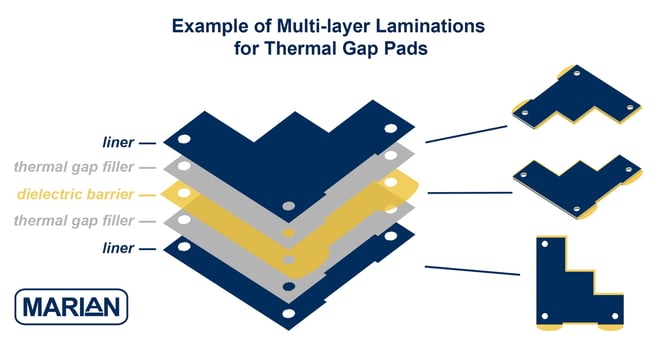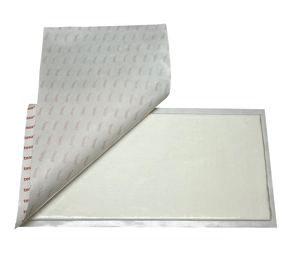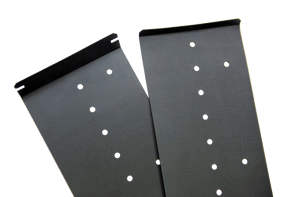Combining Intricate Laminations to Create Multifunctional Parts
Electric vehicles (EVs) continue to experience a sharp growth trajectory, generating process advancements and additional application requirements and needs. Marian has developed improved solutions to meet the industry’s most critical necessities for battery longevity, performance, and passenger safety.
Below we examine some of these requirements and the complex, die-cut EV battery components Marian manufactures to overcome common challenges related to the battery.
1. Multi-layer Laminations for Thermal Gap Pads
Multi-layer lamination involves combining two or more materials to create a single composite structure. In the EV industry, this type of lamination is designed to create a compact and efficient battery pack, improving safety during battery operation and permitting easier manual installation.
A great example of a multi-layer lamination for EV batteries is a thermal gap pad. This gap pad consists of a thermal gap filler that is adhered to a liner and a polyimide dielectric barrier, and occasionally, to a second thermal gap filler and liner. This lamination design provides a conformable, thermally conductive interface between an array of hot battery cells and the battery’s cooling plate, while also providing a layer of electrical insulation to prevent random current or electrical discharge.

An example of a multi-layer lamination. This thermal gap pad consists of a dielectric barrier core (polyimide film) between two layers of thermal gap fillers (precision die-cut to size) and two protective liners on the outside of the assembly.
The heat from the battery cells flows through the thermal gap pad to the cooling plate, keeping the battery assembly from overheating. The polyimide dielectric barrier within the lamination prevents contact between metal components within the battery cells to avert a short circuit. Although thin, the central layer of dielectric film is tough and can prevent cut-through from burrs or sharp edges on rough or unpolished metal surfaces.
It is a common practice for layers within these assemblies to be shaped with different geometries. Marian is capable of bringing differently layered shapes together in one laminated assembly.
2. Battery Flame Barrier Encapsulation
Battery flame barrier encapsulation is the process of forming a barrier around a battery component that is prone to shed particulates, such as fibers from an organic paper or flakes from a sheet mica. Some fragile materials within the battery can be prone to shedding electrically conductive fragments that could short out components in the battery and even spark a fire.

Marian encapsulates flame barriers, graphite heat spreaders, and other high-performing materials that, by their nature, are delicate structures. Encapsulated materials become dielectrically stable, abrasion resistant, and more compatible within the battery system.
As a value-added benefit, battery encapsulation can involve the use of pressure sensitive adhesives (PSAs), which allows the component to act as a bonding point between other components including the battery cells themselves. Additional benefits include safeguarding against moisture and temperature variations, as well as ensuring a longer and safer life of the battery.
The image here shows a custom flame barrier compression battery pad encapsulated with adhesive for EV application.
3. Perforation Die Cutting and Scoring
 Perforations (precise and uniform slits) and scoring (bias inducing creases) are processes that allow for the folding and alteration of what are normally two-dimensional components. These features can be strategically placed to improve ease of assembly.
Perforations (precise and uniform slits) and scoring (bias inducing creases) are processes that allow for the folding and alteration of what are normally two-dimensional components. These features can be strategically placed to improve ease of assembly.
Marian can add perforations to laminations by die cutting consistent punctures through thermal materials. Die cutting perforations in complex laminations requires accurate and tight tolerances. Poorly die-cut or misplaced features can disrupt the placement of the entire assembly, potentially leading to premature failures.
ITW Formex® (shown here) is a great material for perforations and scoring. For more information, see our material spotlight here.
With our continued leadership in the industry, Marian will remain the preferred provider of complex EV battery components for years to come. Contact us today to learn more about our multifunctional electric vehicle solutions!



